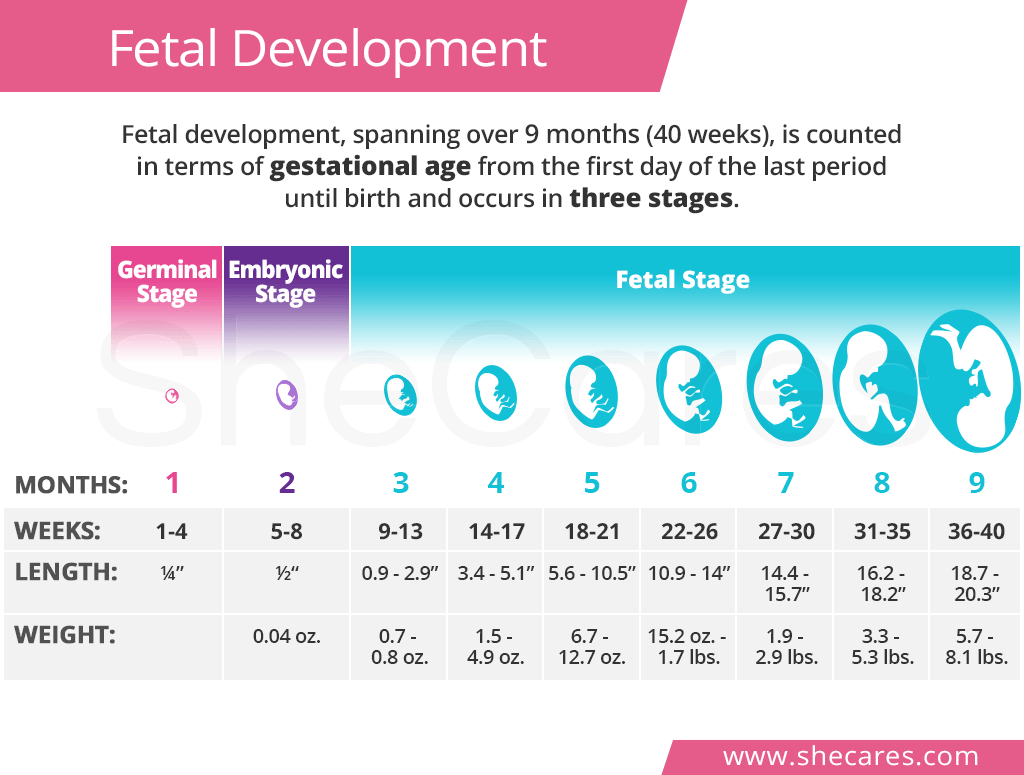Month 1: Baby at 1 – 4 weeks
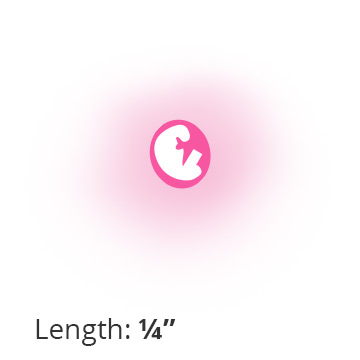
The first stage of fetal development, called germinal stage, starts from ovulation around the 2nd week of gestation. Once fertilized, the egg begins multiplying as it travels to the uterus to implant itself in its wall. This triggers the pregnancy hormone, human chorionic gonadotropin (HCG), being secreted and showing up on a pregnancy test about two weeks later.
As the eggs grows, a fluid-filled amniotic sac starts to develop around it to cushion and protect it. A part of it will later become the placenta for nutrients and oxygen supply. For now, nutrients necessary for the rapidly growing embryo are provided through an attached small yolk sac.
Month 2: Baby at 5 – 8 weeks
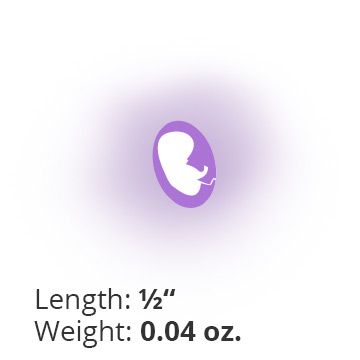
As the embryo continues to grow and enters the next stage, called embryonic, the initial shape of its nervous system, facial features, main organs, and extremities starts to show. Very importantly, the neural tube forms, too. As such, it is crucial to take prenatal vitamins upon pregnancy confirmation as neural tube defects can happen in the very first weeks of conception.
Another big milestone in this stage of fetal development is the detection of fetal heartbeat, which is generally possible during the first prenatal visit around the eighth week.
Month 3: Baby at 9 – 13 weeks
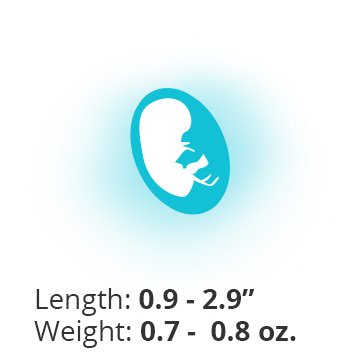
A baby at 10 weeks is referred to as a fetus, and the third development stage, called fetal, begins and lasts until birth. The limbs and organs are fully formed and functioning. Blood is being circulated, and the liver is producing bile. Although the baby's reproductive organs are developing, determining the gender on ultrasound will not be possible for another several weeks.
With the end of the twelfth week of gestation, the first trimester ends, and the risk of miscarriage is significantly reduced.
Month 4: Baby at 14 –17 weeks
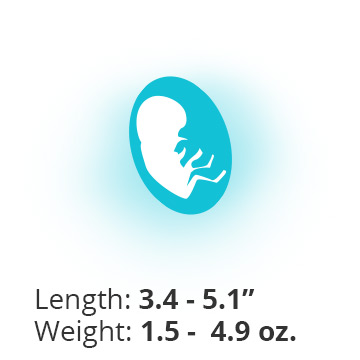
In the next month of fetal development, the nervous and immune system begin to function, and the baby starts releasing urine into the amniotic fluid. She or he can also yawn, make facial expressions, suck on a thumb, and sense light from the outside, although the eyes are still shut and will continue so until the end of the second trimester.
Starting at the fourth month, a woman's pregnancy belly starts to show, and early pregnancy signs and symptoms tend to lessen.
Month 5: Baby at 18 – 21 weeks
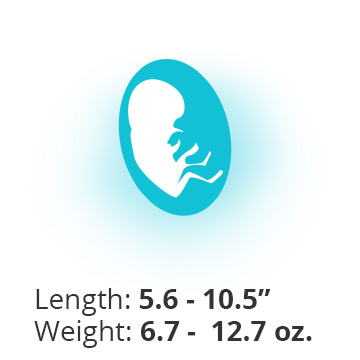
Around the fifth month, the baby in the womb starts making first movements, called quickening. Women who have been pregnant before might feel fetal kicks two to three weeks sooner. The baby's skin is covered in lanugo (fine, soft hair) and then a protective, whitish coating called vernix caseosa, both of which are shed before birth.
A prenatal ultrasound done between the 18th and 20th weeks can reveal the baby's gender, although it may sometimes be possible earlier, after the 12th week.
Month 6: Baby at 22 – 26 weeks
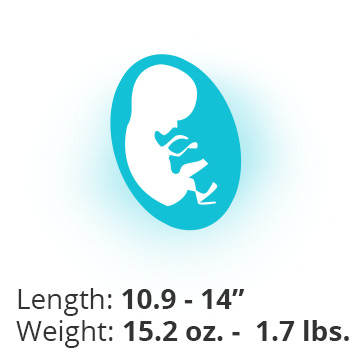
Entering the sixth month of fetal development, the baby can hear and respond to sounds from the outside, such as people's voices. She or he also can feel when the mother is changing positions and moving. The fingerprints are formed; the brain develops rapidly; the digestive tract and lungs continue to mature, and a woman might feel the baby hiccup.
After the 23rd week of pregnancy, the baby has chances of survival in the intensive care unit if born prematurely.
Month 7: Baby at 27 – 30 weeks
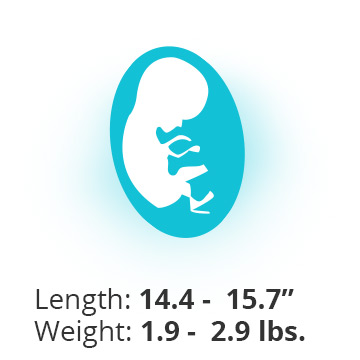
As the third trimester begins, the baby in the womb is very active, moving and kicking more vigorously. Around this time, a woman is encouraged to start counting baby kicks. By the end of the 28th week, the baby starts to partially open and close the eyes, and all organs are mature and working, except for the lungs.
In the next few weeks, there will be a significant increase in baby's weight gain. Towards the end of the month, the baby will take on the fetal position until birth.
Month 8: Baby at 31 – 35 weeks
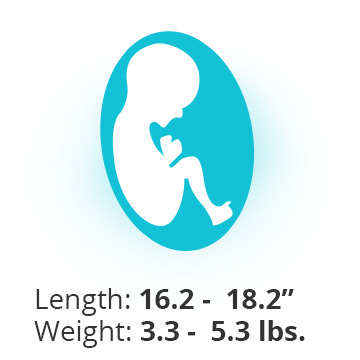
In the eighth month of fetal development, lanugo begins to diminish, the skin smoothens and becomes less wrinkled, and the baby grows eyebrows, eyelashes, and full-length finger- and toenails. The brain is growing very rapidly. The baby continues gaining weight, kicking, and taking up more and more space in the womb.
Although not yet considered “full term,” the baby has high chances of surviving outside of the womb, if a premature birth was to take place.
Month 9: Baby at 36 – 40 weeks
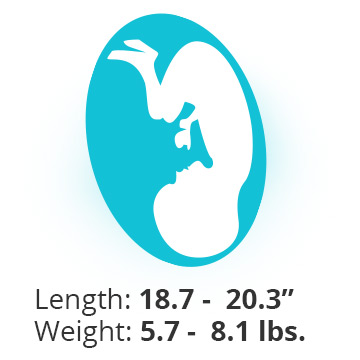
The ninth month of pregnancy is the last phase of baby's development. All organs, including the lungs, are fully mature and functioning. About two to four weeks before childbirth, baby dropping takes place, which is when the baby descends in the pelvis with its head towards the birth canal in preparation for labor and delivery (a position called vertex).
Although it is accepted that a normal pregnancy can last between 37 to 42 weeks, according to new guidelines, pregnancies are “full term” between 39 weeks 0 days and 40 weeks and 6 days.
Key Takeaways
During 40 weeks of pregnancy, the baby grows from a rapidly multiplying ball of cells measuring no more than a quarter of an inch to a fully-developed human averaging 20 inches and 8 pounds. This impressive fetal development occurs in three stages: germinal covering the first month of pregnancy, embryonic happening during the second month of pregnancy, and fetal, which begins at week nine and lasts all the way until birth. Each of those stages of fetal development is characterized by its own milestones, like the detection of fetal heartbeat at week 8, first kicks at week 18, or gender reveal at week 20. Thanks to medical advancements, many of those events in the life of a baby in womb can be tracked through various prenatal tests to ensure that the baby has the safest and healthiest environment necessary for his or her growth.
Sources
- Cleveland Clinic. (2014). Fetal Development: Stages of Growth. Retrieved May 30, 2019 from https://my.clevelandclinic.org/health/articles/7247-fetal-development-stages-of-growth
- Embryology. (2019). Fetal Development. Retrieved May 30, 2019 from https://embryology.med.unsw.edu.au/embryology/index.php/Fetal_Development
- March of Dimes. (2018). What is Full Term? Retrieved May 30, 2019 from https://www.marchofdimes.org/pregnancy/what-is-full-term.aspx
- Medline Plus. (2019). Fetal development. Retrieved May 30, 2019 from https://medlineplus.gov/ency/article/002398.htm
- National Child & Maternal Health Education Program. (n.d). Full-Term Pregnancy. Retrieved May 30, 2019 from https://www1.nichd.nih.gov/ncmhep/initiatives/know-your-terms/Pages/moms.aspx
- Office on Women's Health. (2019). Stages of pregnancy. Retrieved May 30, 2019 from https://www.womenshealth.gov/pregnancy/youre-pregnant-now-what/stages-pregnancy
- Sutter Health. (n.d.). Fetal development. Retrieved May 30, 2019 from http://www.babies.sutterhealth.org/babygrowth/fetaldev/index.html
